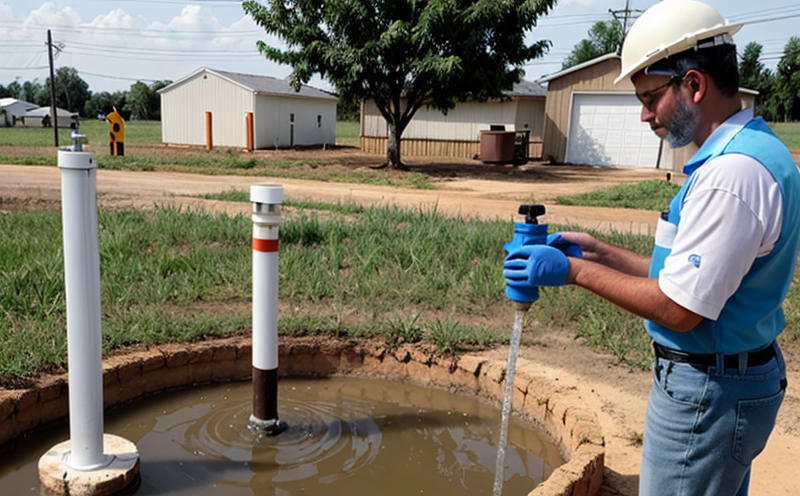EPA Method 335.4 Cyanide in Groundwater Testing
The Environmental Protection Agency (EPA) Method 335.4 is a standard analytical technique for determining cyanide concentration in groundwater samples, which is critical for environmental and public health protection. This method provides precise quantitative results that comply with regulatory requirements.
Cyanide, specifically hydrogen cyanide (HCN), is toxic to humans and aquatic life. It can be released into the environment through various industrial activities, urban runoff, or agricultural practices. Groundwater serves as a vital water resource for drinking supplies and irrigation, making its quality monitoring essential.
EPA Method 335.4 involves several steps including sample collection, preservation, digestion, and measurement using an ion-selective electrode (ISE) in conjunction with colorimetric or photometric analysis. The method is designed to ensure accurate results, which are crucial for compliance with local, state, and federal regulations.
Groundwater samples may contain other contaminants that also require monitoring, such as nitrate, arsenic, lead, and volatile organic compounds (VOCs). EPA Method 335.4 is often part of a comprehensive suite of tests to ensure the overall quality and safety of groundwater resources.
The method's precision and accuracy are validated through rigorous quality control measures and inter-laboratory comparisons. Laboratories adhering to this standard must follow strict protocols for sample handling, calibration, and analysis to maintain consistency and reliability across different testing facilities.
Groundwater monitoring is essential in both urban and rural areas where it plays a significant role in water supply systems. Regulatory compliance with EPA Method 335.4 helps ensure that groundwater meets the stringent safety standards set by regulatory bodies, protecting public health and environmental integrity.
The application of this method extends beyond mere compliance; it provides critical data for informed decision-making processes related to land use planning, water resource management, and pollution control strategies. By leveraging EPA Method 335.4, stakeholders can take proactive measures to mitigate risks associated with cyanide contamination in groundwater.
Why It Matters
Cyanide in groundwater poses significant health risks and environmental hazards, making its detection and quantification imperative for regulatory compliance. Cyanide poisoning can cause severe health issues ranging from mild symptoms like nausea to more serious conditions such as respiratory failure or even death.
Groundwater contamination by cyanide is often attributed to industrial processes involving metal refining, electroplating, and pesticide manufacturing. Agricultural practices using certain fertilizers or herbicides may also contribute to cyanide pollution. Therefore, regular monitoring of groundwater quality through methods like EPA 335.4 helps in identifying potential sources of pollution early on.
From a regulatory perspective, compliance with such standards ensures that water supplies meet the safety thresholds set by environmental protection agencies worldwide. This not only safeguards public health but also supports sustainable development goals by minimizing ecological damage caused by cyanide contamination.
The significance of EPA 335.4 extends beyond mere detection; it plays a crucial role in informing remediation efforts and policy formulation aimed at preventing future occurrences of cyanide pollution. By providing reliable data, this method empowers stakeholders to implement effective mitigation strategies, thereby contributing significantly towards maintaining clean and safe groundwater resources.
International Acceptance and Recognition
- EPA Method 335.4 is widely accepted in the United States for cyanide testing in groundwater, but its principles are also aligned with international standards such as ISO 17025 for quality management systems.
- The method's precision and accuracy have been validated through various inter-laboratory comparisons conducted by reputable organizations like the National Institute of Standards and Technology (NIST).
- It is recognized globally, especially in countries with similar environmental regulations regarding cyanide discharge limits into surface waters or soil.
Use Cases and Application Examples
In practice, EPA Method 335.4 is used by various entities including government agencies responsible for environmental monitoring, private companies involved in mining operations, and agricultural firms concerned about runoff pollution.
For instance, a mining company operating near a body of groundwater might use this method to monitor the water quality post-mining activities. Similarly, an agricultural cooperative could employ it to ensure that their fertilizers do not lead to cyanide contamination in nearby wells or streams.
This method is also utilized during remediation projects where contaminated sites need thorough investigation and cleanup. By regularly applying EPA Method 335.4, professionals involved in these projects can track the effectiveness of their remedial actions and ensure that they adhere to strict regulatory guidelines.
Moreover, universities conducting research into cyanide toxicity or its environmental impact would find this method invaluable for their studies. It provides them with consistent, reliable data which is crucial when presenting findings to academic journals or stakeholders.





